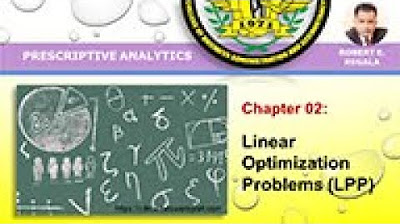#1 LPP formulation problem with solution | Formulation of linear programming problems | kauserwise®
Summary
TLDRThis video explains the formulation of the Linear Programming Problem (LPP) model, focusing on its key components such as decision variables, objective functions, and constraints. It walks through a practical problem involving two products, A1 and A2, produced using milling and drilling machines. The video demonstrates how to maximize profit by setting up an LPP model using available resources, processing times, and constraints. Viewers are encouraged to subscribe for more content on operations research, with future videos covering topics like minimization problems in LPP.
Please replace the link and try again.
Q & A
What is the primary objective of the video?
-The primary objective of the video is to explain the formation of a Linear Programming Problem (LPP) model and to solve a maximization problem using the LPP model.
What are decision variables in an LPP model?
-Decision variables represent the levels of achievement for different actions, such as the number of products to be produced, denoted as X1 and X2 for two different products in the problem.
What is the objective function in LPP?
-The objective function is an expression that represents the total profit or cost of performing activities. It can either be maximized (for profit) or minimized (for cost).
How is the objective function formulated in the provided problem?
-The objective function in the provided problem is to maximize profit, represented as Maximize Z = 25X1 + 35X2, where 25 and 35 are the profits per unit for two products A1 and A2 respectively.
What are technological coefficients in an LPP?
-Technological coefficients represent the amount of resources required for each activity. They are often arranged in a matrix format, showing how much of a resource (e.g., machine time) is needed for each product.
What is resource availability in the LPP model?
-Resource availability refers to the maximum amount of resources (e.g., hours on machines) that are available during the planning period. In this problem, the milling machine has 80 hours available, and the drilling machine has 60 hours available.
What are constraints in an LPP model?
-Constraints represent the restrictions or limitations on the resources used for activities. They define the limits of resource usage to ensure the total usage does not exceed available resources.
What is the non-negativity constraint in an LPP model?
-The non-negativity constraint ensures that all decision variables (such as production volumes X1 and X2) must be greater than or equal to zero, meaning that negative production is not allowed.
How is the milling machine constraint formulated in the problem?
-The milling machine constraint is 10X1 + 15X2 ≤ 80, where 10 and 15 are the hours required for products A1 and A2, and 80 is the maximum available hours on the milling machine.
How is the drilling machine constraint formulated in the problem?
-The drilling machine constraint is 8X1 + 10X2 ≤ 60, where 8 and 10 are the hours required for products A1 and A2, and 60 is the maximum available hours on the drilling machine.
What is the overall goal of the LPP model in this problem?
-The overall goal of the LPP model is to determine the production volumes X1 (for product A1) and X2 (for product A2) that will maximize the total profit while ensuring the constraints for machine hours are not violated.
Outlines

This section is available to paid users only. Please upgrade to access this part.
Upgrade NowMindmap

This section is available to paid users only. Please upgrade to access this part.
Upgrade NowKeywords

This section is available to paid users only. Please upgrade to access this part.
Upgrade NowHighlights

This section is available to paid users only. Please upgrade to access this part.
Upgrade NowTranscripts

This section is available to paid users only. Please upgrade to access this part.
Upgrade NowBrowse More Related Video

PROGRAM LINIER - METODE GRAFIK - RISET OPERASI

Integer Linear Programming - Binary (0-1) Variables 1, Fixed Cost

Linear Programming 1: Maximization -Extreme/Corner Points (LP)

Linear Programming dengan Metode Grafik

ART TEACHES MATHEMATICS IN THE MODERN WORLD-LESSON 1: INTRO TO LINEAR PROGRAMMING

Ch04 Linear Programming
5.0 / 5 (0 votes)